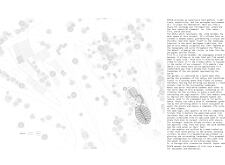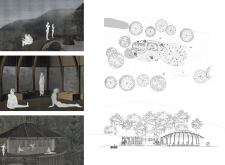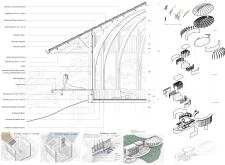5 key facts about this project
At first glance, the architectural design of the pavilion captivates with its organic forms that reflect both the natural environment and the urban setting. The building’s silhouette is characterized by flowing lines and gentle curves, which seamlessly integrate it into the surrounding cityscape. This design approach aims to create a sense of harmony between the built environment and nature, encouraging occupants to appreciate their surroundings. The façade features a combination of materials, including reinforced concrete, glass, cedar wood, and steel, each chosen for its unique properties and contributions to the overall aesthetic.
The use of reinforced concrete establishes a solid foundation and structural integrity for the pavilion, allowing for expansive open spaces within. High-performance glass envelops the building, maximizing natural light while ensuring energy efficiency through low-emissivity properties. This design element not only enhances the interior environment but also blurs the boundaries between indoors and outdoors, inviting visitors to engage with the natural light throughout the day. Additionally, the inclusion of cedar wood cladding offers warmth and texture, contributing to a welcoming atmosphere that encourages community interaction.
Steel plays a crucial role in the structural framework, maintaining stability while allowing for large, uninterrupted interior spaces. This flexibility in design enables the pavilion to adapt to various functions, whether hosting an art exhibition or a community gathering. The thoughtful incorporation of a green roof system further emphasizes the project’s commitment to sustainability, providing insulation, enhancing biodiversity, and establishing a connection to the natural world. This rooftop space not only creates a visually appealing element but also demonstrates the potential for urban locations to incorporate green spaces effectively.
One of the unique design approaches of the XYZ Pavilion lies in its integration of smart technologies, including automated climate control systems that monitor and adjust the indoor environment based on real-time data. This feature responds to Chicago’s variable climate, optimizing energy use and providing a comfortable experience for visitors throughout the seasons. Moreover, the pavilion reflects local historical influences, with architectural cues that honor the traditional buildings of Chicago. This thoughtful connection to its surroundings enriches the narrative of the space, providing a sense of place and continuity in the urban fabric.
Beyond its architectural form and function, the XYZ Pavilion stands as a beacon for community engagement and creativity. The flexible interior layout allows for movable partitions, enabling the space to transform seamlessly for various events. Outdoor seating areas encourage social interaction and provide opportunities for reflection, promoting a sense of belonging among users. This project exemplifies the power of architecture to create meaningful experiences that enhance daily life in the city.
For those eager to delve deeper into the architectural intricacies of the XYZ Pavilion, a closer examination of the architectural plans, sections, and design ideas will reveal the thoughtful considerations that shaped this project. The exploration of these elements will provide valuable insights into the architectural process and the overarching themes that define this innovative pavilion. By engaging with the project’s presentation, readers can gain a comprehensive understanding of how design, function, and community come together in this noteworthy endeavor.


























